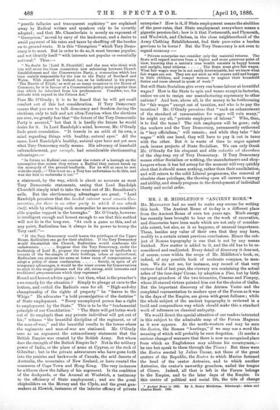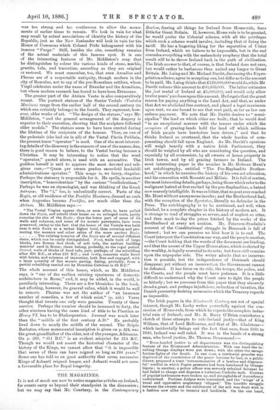MR. J. H. MIDDLETON'S "ANCIENT ROME."*
ME. MIDDLETON had no need to make any excuse for writing this book. The Ancient Rome of to-day is a different place from the Ancient Rome of even ten years ago. Much energy has recently been brought to bear on the work of excavation, and discoveries have been made which are not only of consider- able extent, but also, as it so happens, of unusual importance. These, besides any value of their own that they may have, modify to a certain extent previous conclusions. Hence the sub- ject of Roman topography is one that is not by any means finished. New matter is added to it, and the old has to be re- considered and readjusted. Every detail of discovery it does not, of course, come within the scope of Mr. Middleton's book, or, indeed, of any possible book of moderate compass, to men- tion. We do not see, for instance, any record of that very curious find of last year, the cinerary urn containing the actual ashes of the four-days' Cmsar, by adoption a Piso, but by birth the great-grandson of the two triumvirs, Crassus and Pompey, whose ill-starred virtues pointed him out for the choice of Galba. But the important discovery of the Atrium -Pestle and the completed representation to modern eyes of the Forum as it was in the days of the Empire, are given with great fullness ; while the whole subject of the ancient topography is reviewed in a lucid and compendious way which should make this a standard work of reference on classical antiquity.
We would direct the special attention of our readers interested in this subject to the admirable map of the Foram Magnum as it now appears. At the north-western end may be seen the Rostra, the Roman "hustings," if we may use a word the meaning of which will probably be soon forgotten. (It marks a curious change of manners that there is now no recognised place from which an Englishman may address his countrymen,— he can but speak to them through the Times.) But these were the Rostra erected by Julius Ca3sar, not those of the great orators of the Republic, the Rostra to which Marine fastened the head of the orator Antonius, and to which another Antonius, the orator's unworthy grandson, nailed the tongue of Cicero. Indeed, all that is left in the Forum belongs to the Empire, and to the later days of the Empire. In this centre of political and social life, the tide of change dbuisat Rams in 1885. By Jr. Henry Middleton. Edinburgh : Adam and Charles Black. 1885.
was too strong and too continuous to allow the monu- ments of earlier times to remain. We look in vain for what may recall by actual associations of identity the history of the Republic, just as the New Zealander will look in vain for the House of Commons which Colonel Pride beleaguered with his famous "Purge." Still, besides the site, something remains • of the actual materials of this famous spot. It is one of the interesting features of Mr. Middleton's map that be distinguishes by colour the various kinds of stone, marble, granite, tufa, and travertine, according as they are original or restored. We must remember, too, that even Arcadius and Phocas are of a respectable antiquity, though modern in the city of Romulus, not to say of the pre-Romulean settlers, whom Virgil celebrates under the name of Evander and the Arcadians, but whom modern research has found to have been Etruscans. The greater part of the Atrium Vestw is also comparatively
recent. The portrait statues of the Senior Vestals (Vestales Maximo) range from the earlier half of the second century (to which one certainly belongs) to the fourth. They represent, how- ever, older works of art. "The design of the statues," says Mr.
Middleton, "and the general arrangement of the drapery is superior to their execution, showing that the sculptors followed older models." The statues seem to have been erected during the lifetime of the recipients of the honour. Thus, on one of the pedestals (she had six in all) of the Vestal Flavia Publicia, the present tense " operatur " is used. One of the most interest- ing details of the discovery is the erasure of one of the names, due, there is good reason to believe, to the Vestal having become a 'Christian. It may be interesting to notice that the word " operatur," quoted above, is used with an accusative. The goddess herself is said to approve the most devoted and reli- gious care,—" Quam per omnes gradus sacerdotii laudabili .adrninistratione operatur." This usage is, we fancy, singular.
Perhaps the statuary is responsible for it. He spells, in another inscription, " benevolentiam " by the curious "benibolentiam." Perhaps he was an etymologist, and was thinking of the Greek Aot'ootActt. The " i," too, is undoubtedly correct. Parts of the Regia, or old residence of the Pontifex Maximus, disused as such when Augustus became l'ontifex, are much older than the -Atrium. Mr. Middleton says :— "The Vestal Virgins appear then, or soon after, to have pulled down the Regia, and rebuilt their house on au enlarged scale, partly 'covering the site of the Regia ; thus the lower part of some of its walls and columns, and some of its mosaic pavements, have been preserved, owing to the fact that the house of the Vestals was built over it with floors at a rather higher level, thus covering and pro- tecting the mosaics and other relics of the more ancient Regia.
The existing remains of the Regia are of several different dates, which can be easily distinguished. First, walls built of large blocks, two Roman feet thiok, of soft tufa, the earliest building material used in Rome; these belong, probably, to the regal period. Second, walls of blocks of bard tufa, part, perhaps, of the rebuilding after 390 B.C., or after 210 B.C.; and lastly, concrete walls faced with bricks, and columns of travertine, both free and engaged, with a large quantity of fine mosaic paving, dating, probably, from a partial rebuilding carried out by Domitius Calvinus in 35 B.C."
The whole account of this house, which, as Mr. Middleton says, is "one of the earliest existing specimens of domestic architecture in Rome," and, it may be added, in the world, is peculiarly interesting. There are a few blemishes in the book, not affecting, however, its general value, which it would be well to remove. Plautus was not the author of "an immense number of comedies, a few of which exist." (p. xiii.) Varro thought that twenty-one only were genuine Twenty of these survive. Perhaps the number should be increased to forty, the other nineteen having the same kind of title to be Plautian as Henry VI. has to be Shakespearian. Juvenal was much later than the "middle of the first century A.D." He probably lived down to nearly the middle of the second. The Scipio Barbatus, whose monumental inscription is given on p. 424, was the great-grandfather of the elder, not of the younger, Africanus. On P. 289, "414 B.C." is an evident misprint for 214 B.C. Though we would not assert the historical character of the history of the Kings, we cannot allow that "it is impossible that seven of them can have reigned so long as 244 years." Some one has told us on good authority that seven successive Kings of Ashanti reigned longer, and Ashanti would not seem a favourable place for Royal longevity.



































 Previous page
Previous page